|
Centrip Editorial Board
Walking the Land of Gods: The Kumano Grand Shrines

In 2004 the Kumano Kodo became a UNESCO World Heritage Site. It is a popular worldwide-tourist destination as one of only two pilgrimage paths designated as World Heritage Sites.
Kumano Kodo is not a single path but the collective name for five pilgrimage routes passing through the Kumano area. These routes pass through three grand shrines (Kumano Hongu Taisha, Kumano Hayatama Taisha, and Kumano Nachi Taisha) and one temple (Seiganto-ji), known as the Kumano Grand Shrines.
The Kumano area has never been easier to access since the Kumano Owase Road opened in 2021. Here is a sample hike for visitors; who want to visit the Kumano Grand Shrines from the Nagoya area.
Table of Contents
- Kumano Kodo and Kumano Pilgrimage
- How to Visit the Kumano Grand Shrines
- Kumano Nachi Taisha and Nachi Great Falls
- Kumano Hayatama Taisha and Kamikura Shrine
- Kumano Hongu Taisha and Oosaihara Shrine
- Directions to the Kumano Grand Shrines from Nagoya
- Recommended Accommodation: Fairfield by Marriott Mie Kumano Kodo Mihama
- Wrap-up
Kumano Kodo and Kumano Pilgrimage
The steep paths will astonish you, even on a short walk along the Kumano Kodo.
In the late Heian Period (around the 11th to 12th century), emperors, after relinquishing the imperial throne, began visiting Kumano, overcoming the steep path. For example, Emperor Shirakawa visited Kumano 9 times, Emperor Toba 21 times, and Emperor Go-Shirakawa a whopping 34 times. Kumano pilgrimage took about one month. They eventually spread to samurai and commoners alike and are known as the Ants' Pilgrimage to Kumano because of the many people lined up on their way to Kumano, like ants lining up in a queue.
But why did they cross such steep mountain paths and take longer to reach the Kumano region?
Since ancient times, Kumano was a remote area closed off by deep mountains, thick forests, sheer cliffs, cascading waterfalls, and strange rock formations. The people of Kumano lived in awe of the inhospitable nature of the area, challenging it and eventually coming to worship it.
The gods descended to the land of Kumano are the Kumano Gongen. Belief in the Kumano Grand Shrines has deep ties to the syncretism of Shintoism and Buddhism. Gongen is a deity who appeared in this world in the guise of a Buddha. Under this syncretism, Buddha and Shinto deities are enshrined together.
Kumano is where the deity Kumano Gongen descended, and overcoming the hardships of pilgrimage to this place leads to salvation. Such faith, combined with a yearning for the beauty of the natural surroundings, led to the tradition of Kumano pilgrimages.
The Kumano Grand Shrines Pilgrimage
Before starting the Kumano Grand Shrines pilgrimage, there are a few things you need to know. Each of the three shrines is about 20 to 40 kilometers apart. It might sound far, but it is possible to visit all three in a single day by car or bus.
In the past, it was necessary to travel from Kyoto and visit the shrines in a specific order: Kumano Hongu Taisha, then Kumano Hayatama Taisha, and finally Kumano Nachi Taisha. But today, there are no restrictions, so take the most convenient route depending on your mode of transportation. We'll assume that you are traveling by car from Nagoya, starting at Kumano Nachi Taisha, the most distant and longest to visit. Followed by Kumano Hayatama Taisha, and ending with Kumano Hongu Taisha.
Kumano Nachi Taisha and Nachi Great Falls
Kumano Kodo Nakahechi Road Daimonzaka
Park your car in the lot near the Daimonzaka bus stop in front of the shrine. Then walk along the Kumano Kodo to get a feel for the Kumano pilgrimage of yesteryear.
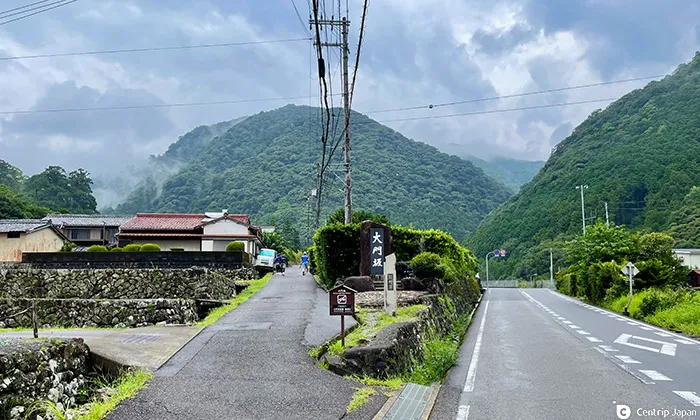 Entrance to Daimonzaka, Kumano Kodo Nakahechi Road
Entrance to Daimonzaka, Kumano Kodo Nakahechi Road
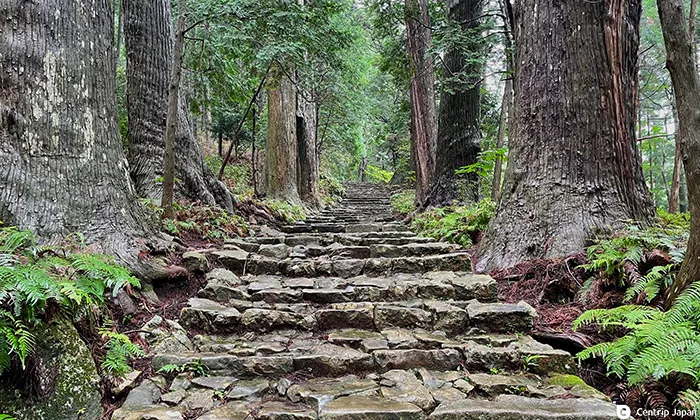 Beautiful moss-covered stone stairs
Beautiful moss-covered stone stairs
After parking your car, walk up the driveway till you see a sign that reads Daimonzaka. Turn away from the road to the left, and you will find a pair of cedar trees, said to be 800 years old. Between them, a beautifully stone-paved path leads on. Daimonzaka is part of the main route called Nakahechi, which connects the Kumano Grand Shrines along the five Kumano Kodo pilgrimage routes.
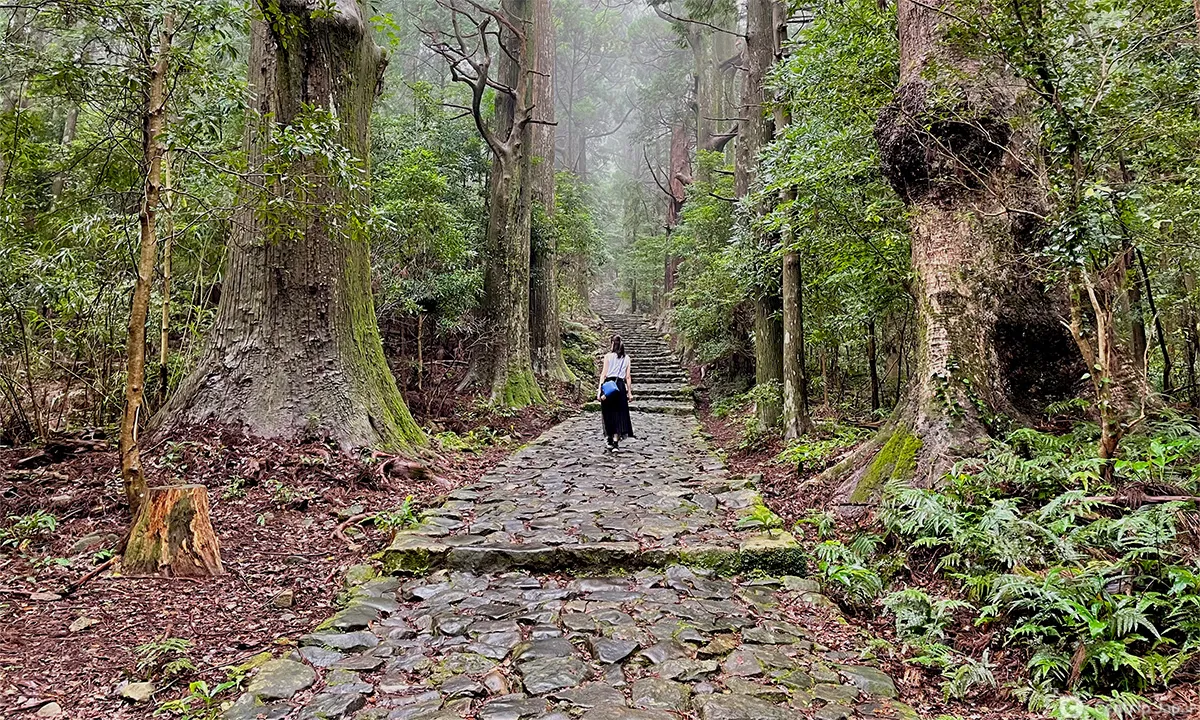 Daimonzaka is more divine after it rains
Daimonzaka is more divine after it rains
The path at Daimonzaka is approximately 600 meters long with a height difference of 100 meters. After it rains, the beauty of this divine is enhanced. But the cobblestones get slippery, so watch your step.
If you want to visit Kumano Nachi Taisha without hiking on Daimonzaka or taking the stairs, use the Seiganto-ji Temple parking lot. There is no parking fee, but an ¥800 toll is required to access the road here.
Kumano Nachi Taisha and Seiganto-ji Temple
 The main shrine pavilions of Kumano Nachi Taisha
The main shrine pavilions of Kumano Nachi Taisha
After passing through Daimonzaka, you reach the entrance to the Mt. Nachi approach. From here, visit the main shrine of Kumano Nachi Taisha and climb up another long flight of stairs.
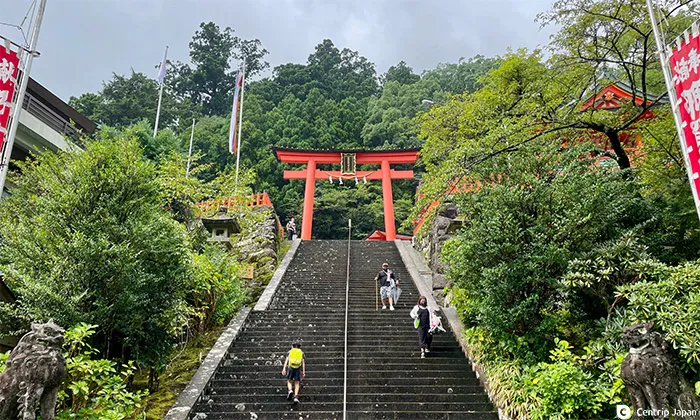 473 steps lead to the main shrine
473 steps lead to the main shrine
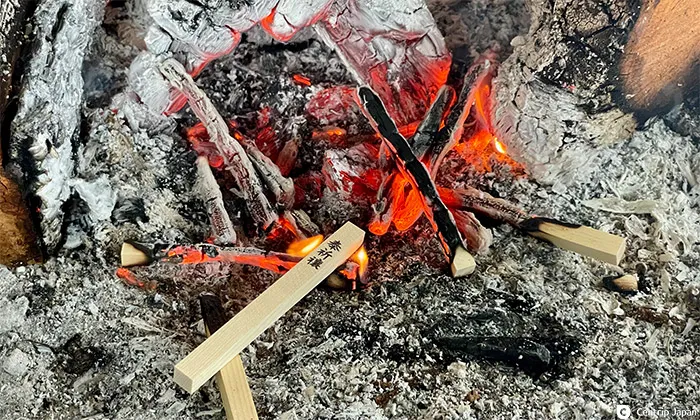 Burning prayer sticks for purification
Burning prayer sticks for purification
The main hall of Seiganto-ji Temple is located to the right of the main shrine of Kumano Nachi Taisha. There is no clear boundary between the grounds of the shrine and Seiganto-ji Temple. The site is a remnant of the Kumano Shinto/Buddhist syncretism.
 The main hall of the historic Seiganto-ji Temple
The main hall of the historic Seiganto-ji Temple
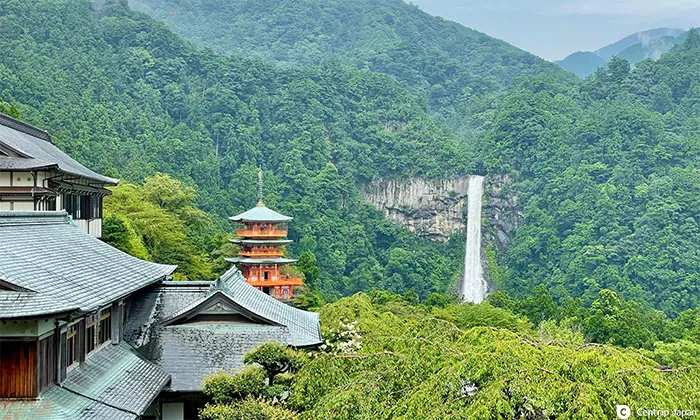 Nachi Falls, as seen from the precincts of Seiganto-ji Temple
Nachi Falls, as seen from the precincts of Seiganto-ji Temple
The main hall of Seiganto-ji Temple is considered one of the oldest buildings in southern Wakayama Prefecture and is a National Important Cultural Property. Proceeding to the north side is an observatory from which you can view the Nachi Falls and the vermilion three-story pagoda. The distant sound of the falls creates a mystical atmosphere.
 The three-story pagoda with Nachi Falls in the background
The three-story pagoda with Nachi Falls in the background
A popular photography spot lies past the precincts of Seiganto-ji Temple and down the stairs toward the three-story pagoda. The three-story pagoda is the main focus of the photos, and you can view it from a different angle than on the observation deck. Visitors can also enter the three-story pagoda, where a Buddha statue is enshrined, and enjoy a view of the Pacific Ocean from the upper level of the pagoda (¥300 entrance fee).
Nachi Great Falls and Hirojinja Shrine
After passing the three-story pagoda, continue down the path to get up close to the waterfall.
Nachi Falls is one of the three most famous waterfalls in Japan. With a 133-meter drop, it is the largest single-level waterfall in the country. Up close, the falls can feel overwhelming. Waterfalls falling in straight lines have been considered sacred since ancient times.
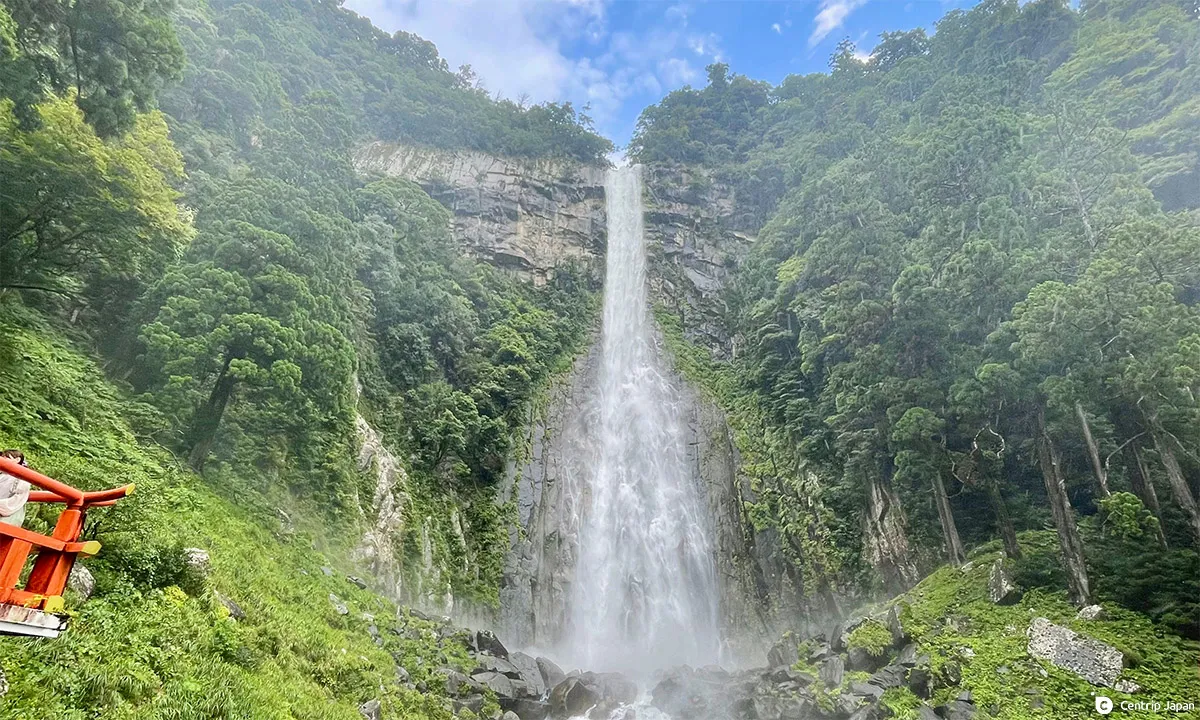 View from the waterfall worship platform at Hirojinja Shrine
View from the waterfall worship platform at Hirojinja Shrine
Below the waterfall is Hirojinja Shrine, a branch temple of Kumano Nachi Taisha. It costs ¥300 for adults and ¥200 for elementary and junior high school students to visit the shrine. Visiting the shrine brings you closer to the waterfall basin, so prepare to be splashed.
 Steep stairs leading to the waterfall
Steep stairs leading to the waterfall
 The rope enshrines the waterfall as a deity
The rope enshrines the waterfall as a deity
It is a 30-minute walk from Nachi Falls back to the Daimonzaka bus stop parking lot. There is a local bus service from the Nachinotaki-mae bus stop to the Daimonzaka bus stop. If your timing is right, you can take this bus on the way back (about 6 minutes, ¥250).
Kumano Hayatama Taisha and Kamikura Shrine
Following Kumano Nachi Taisha, head for Kumano Hayatama Taisha. It is about 20 km from Kumano Nachi Taisha to Kumano Hayatama Taisha. By car, it takes about 40 minutes.
Kumano Hayatama Taisha
 The shrine pavilion of Kumano Hayatama Taisha
The shrine pavilion of Kumano Hayatama Taisha
Kumano Hayatama Taisha is in the center of Shingu City, a 15-minute walk from JR Shingu Station. Originally the shrine was the new shrine of Kamikura Shrine.
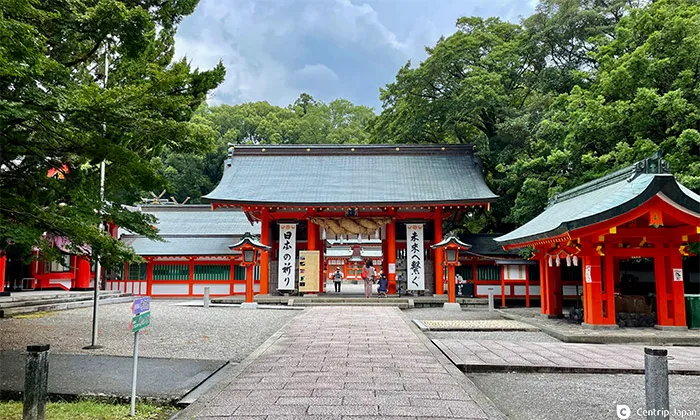 Shinmon gate with the thick sacred rope
Shinmon gate with the thick sacred rope
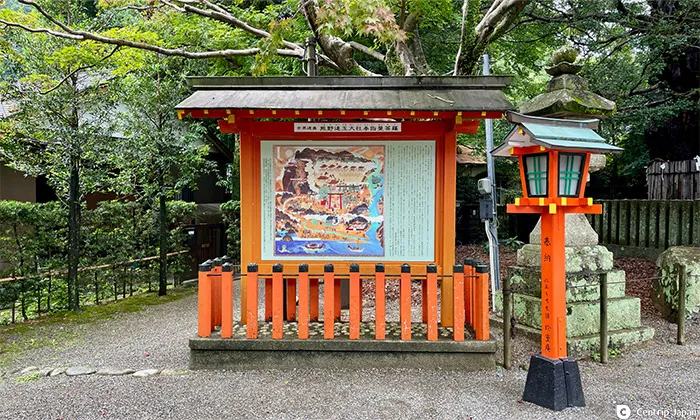 Mandala depicting the emperor's pilgrimage to Kumano
Mandala depicting the emperor's pilgrimage to Kumano
The bright vermilion color of the five pavilions, lined up side by side, is beautiful and impressive. Each of the pavilions enshrines one of the Twelve Kumano deities.
The tree on the temple grounds is a natural monument estimated to be 1,000 years old. Shimpokan museum (admission ¥500) exhibits national treasures and other items remaining at Kumano Hayatama Taisha.
Kamikura Shrine
About 1 km from Kumano Hayatama Taisha lies Kamikura Shrine, considered the "original shrine." Legend has it that the deities of Kumano first descended on a massive rock called Gotobiki Iwa Rock, the object of worship for this shrine.
 Gotobiki Iwa Rock, the object of worship at Kamikura Shrine
Gotobiki Iwa Rock, the object of worship at Kamikura Shrine
Here is where the gods descended, and it is not easy for humans to approach. After passing through the torii gate, a hopelessly steep staircase rises to the top. At the top stands Gotobiki Iwa Rock, from which one can enjoy a panoramic view of Kumano's city center and the ocean beyond.
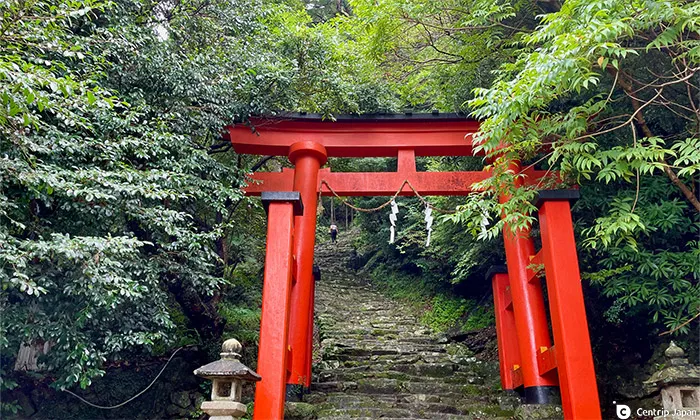 Steep stairs as soon as you pass the torii gate
Steep stairs as soon as you pass the torii gate
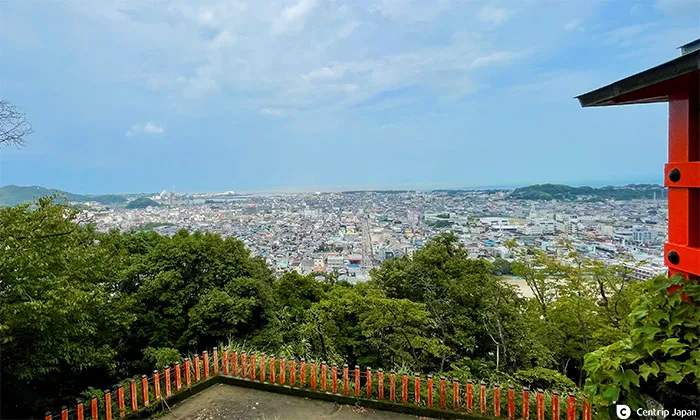 Shingu City seen from Gotobiki Iwa Rock
Shingu City seen from Gotobiki Iwa Rock
The 538-step staircase of Kamikura Shrine is hard to describe in words alone. It is astonishingly steep and is the most challenging point on this tour of the Kumano Grand Shrines.
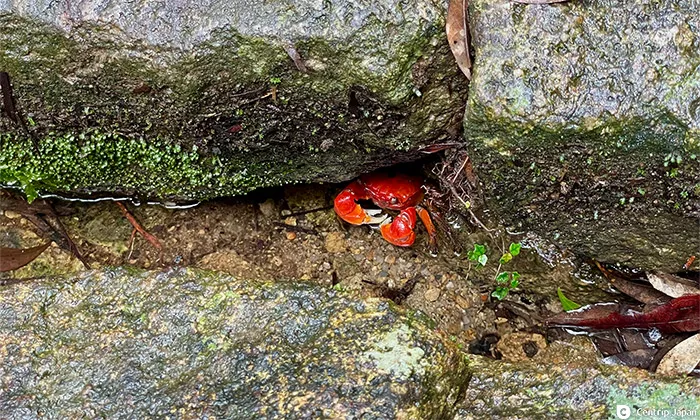 Crabs peeking out from between rocks filled with water
Crabs peeking out from between rocks filled with water
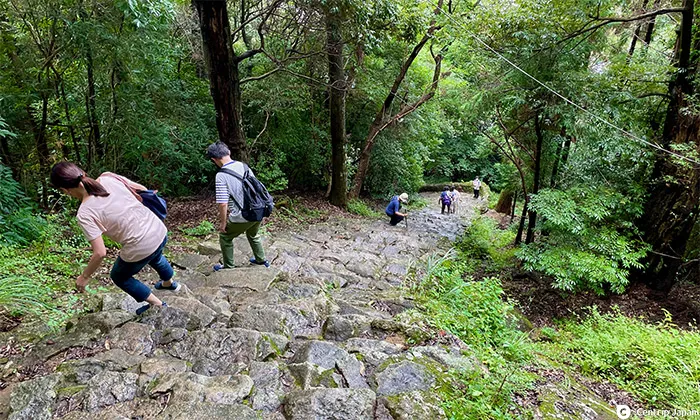 Crab-walking people
Crab-walking people
The climb is very satisfying but make sure you walk it in comfortable shoes.
Kumano Hongu Taisha and Oyunohara
Now head to Kumano Hongu Taisha for the last stop on our tour of the Kumano Grand Shrines. From Kumano Hayatama Taisha to Kumano Hongu Taisha is about 35 km, heading upstream on Route 168 along the Kumano River, and takes about 50 minutes.
Kumano Hongu Taisha
Kumano Hongu Taisha, in Hongu-cho, Tanabe City, is the main shrine of the over 3,000 Kumano Shrines. Among the Kumano Grand Shrines, Kumano Hongu Taisha has a particularly old-fashioned atmosphere.
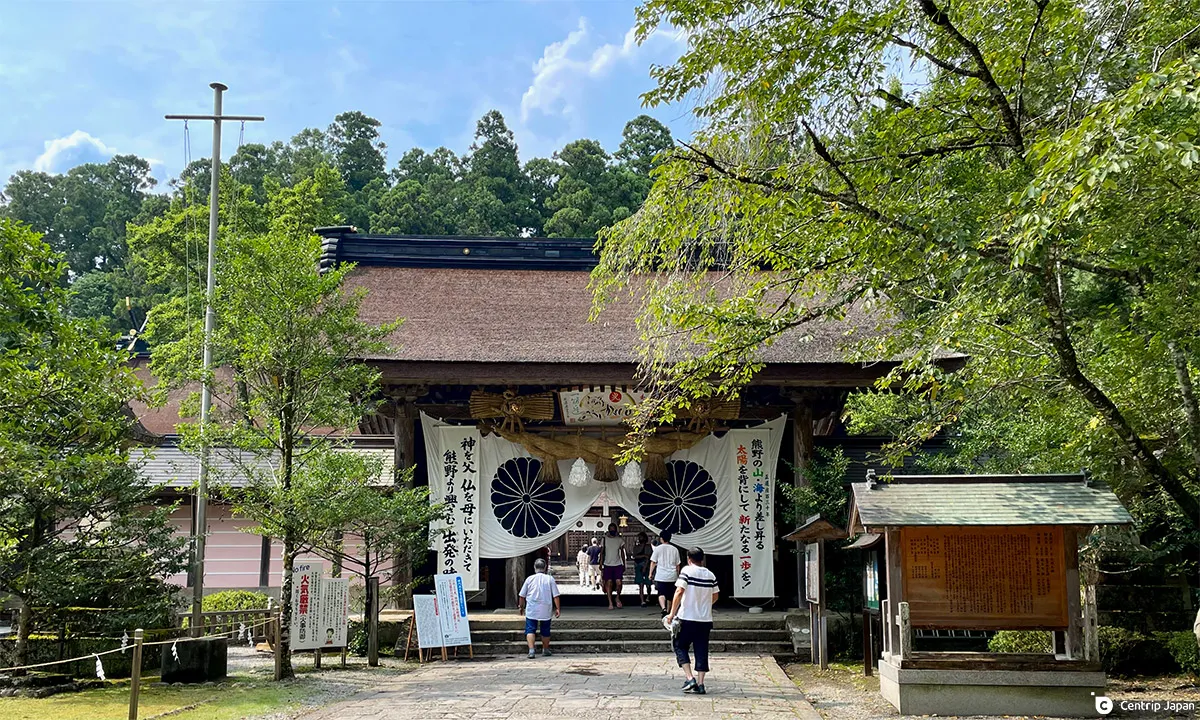 The gate of Kumano Hongu Taisha, no photography beyond this point
The gate of Kumano Hongu Taisha, no photography beyond this point
The pavilions of Kumano Hongu Taisha are similar to those of Kumano Hayatama Taisha. But in contrast to the bright vermilion of Hayatama Taisha, Hongu Taisha's pavilions use an older style of roof characterized by its subdued colors.
 158 steps at the end of the approach
158 steps at the end of the approach
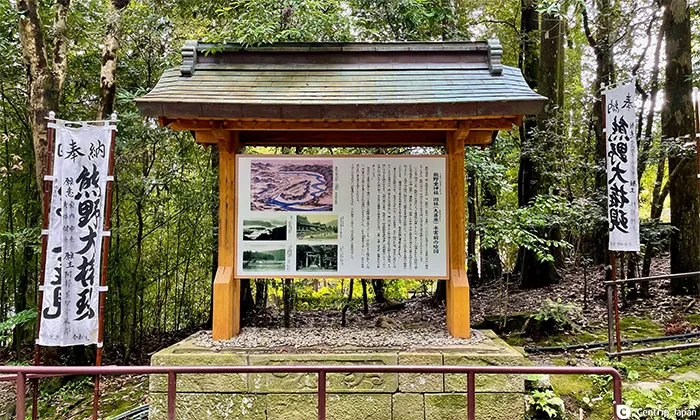 Kumano Hongu Taisha before it flooded
Kumano Hongu Taisha before it flooded
Oyunohara
Oyunohara was the location of Kumano Hongu Taisha until a major flood in 1889, and was said to be eight times larger at that time, than it is today. Currently, a towering torii gate, the tallest in Japan, stands at the entrance to Oyunohara. (Photography is prohibited beyond the torii gate as it is a Shinto sanctuary.)
Oyunohara was the location of Kumano Hongu Taisha until a major flood in 1889, and was said to be eight times larger at that time than it is today. Currently, a towering torii gate, the tallest in Japan, stands at the entrance to Oyunohara. (Photography is prohibited beyond the torii gate as it is a Shinto sanctuary.)
 The view is beautiful with the contrast between the richly harvested ears of rice and the torii gate
The view is beautiful with the contrast between the richly harvested ears of rice and the torii gate
In front of Oyunohara are rice fields. The rice harvested in these fields is used to make kamamochi, a famous confectionery at Kumano Hongu Taisha.
Directions to the Kumano Grand Shrines from Nagoya
Recapping the journey: we began at Kumano Nachi Taisha and Seigando-ji Temple, the furthest from Nagoya and took the most time to visit. Then, we passed through Kumano Hayatama Taisha and Kamikura Shrine, concluding our visit at Kumano Hongu Taisha.
The tour's starting point of Nachi-katsuura Town is a famous tuna fishing port where you can savor fresh seafood at Nigiwai Market. The market is open from 8:00 a.m., so eat a hearty meal in the morning to get ready for the Kumano Grand Shrines tour.
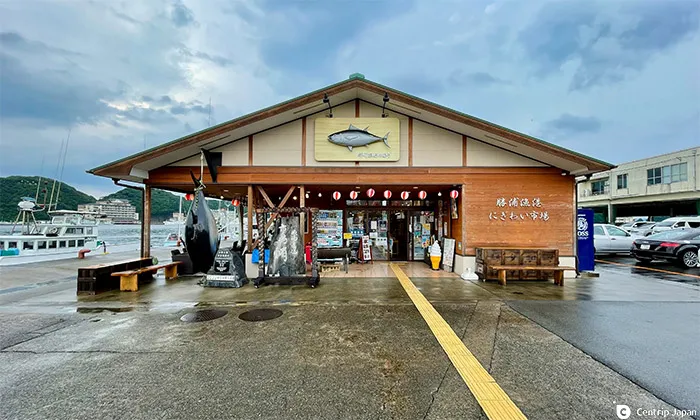 Nigiwai Market, open from 8:00 a.m.
Nigiwai Market, open from 8:00 a.m.
 Fresh sashimi is readily available
Fresh sashimi is readily available
- Kumano Nachi Taisha
Time required: 3 hours, including the hike up Daimonzaka - Kumano Hayatama Taisha and Kamikura Shrine
Time required: 90 minutes - Kumano Hongu Taisha and Oyunohara
Time required: 60 minutes
↓By car: 40 minutes
↓By car: 50 minutes
If you are driving
It takes about 2 hours and 30 minutes from Nagoya to Kumano Nachi Taisha in Nachi-katsuura Town. First, take the Tomeihan Expressway, Ise Expressway, and Kisei Expressway and get off the expressway at the Kumano Odomari IC on Kumano Owase Road. From there, it is about 1 hour via National Route 42. Including rest time, the drive should take about 4 hours.
If you are using public transportation
If you are going to Kumano Nachi Taisha by train from Nagoya, take the JR Kisei Honsen limited express to Kii-Katsuura Station, a 3-hour and 50-minute ride without transfers. From Kii-Katsuura Station, the Kumano Gobo Nankai Bus operates a regular sightseeing bus service to the Kumano Grand Shrines. It departs in the morning, so you must spend the night before in the Kii-Katsuura Station area.

Recommended Accommodation: Fairfield by Marriott Mie Kumano Kodo Mihama
 Exterior of Fairfield by Marriott Mie Kumano Kodo Mihama
Exterior of Fairfield by Marriott Mie Kumano Kodo Mihama
 Stylish lobby lounge
Stylish lobby lounge
 Ocean view room
Ocean view room
After visiting the Three Grand Shrines of Kumano, we recommend staying at Fairfield by Marriott Mie Kumano Kodo Mihama, part of the Marriott International hotel brand.
Right in front of the hotel stretches the beautiful Shichiri Mihama Beach, which has been selected as one of Japan's 100 Best Beaches and is famous as a sunrise viewing spot. You can take leisurely walks along Japan's longest pebble beach. Fairfield by Marriott Roadside Station Hotels are strategically located near Roadside Stations—key hubs for road trips in Japan. This makes them the perfect spot to savor local delicacies and gourmet treats as you continue your journey to the next destination.
Fairfield by Marriott Mie Kumano Kodo Mihama
Wrap-up
With the opening of the Kumano Owase Road in 2021 and the improvements to the surrounding roads, access to the Kumano area has improved dramatically, making it even easier to visit. If you are coming from Nagoya, we recommend visiting the Kumano Kodo Ise Road, which offers hiking along with Magose-toge Pass and the Matsumoto-toge Pass. How about stepping onto one of the ancient paths and imagining the bygone travelers who set out on the Kumano Sanzan?
Click here to get the latest information on Central Japan.Centrip Japan - Nagoya and Chubu Information

